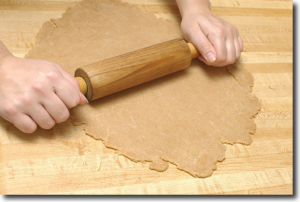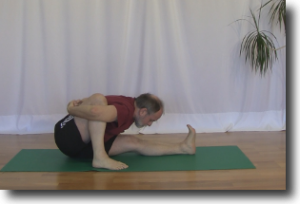Alice’s teacher is watching Alice working on binding in Marichyasana A. Her hands are almost touching behind her back.
“Alice you will have more success with binding if you use the rolling pin factor to work with your Edge.” Her teacher tells her. Alice looks at her teacher with a puzzled look.
“Watch a rolling pin as it creates a pie crust” her teacher explained. “The pin rolls back and forth, back and forth as it stretches the dough out into a circle big enough to fill the pie plate. When you first started out to make the pie crust the dough was not very big at all and now it has stretched far enough to fill the whole pie plate.
You can use the rolling pin factor in combination with your Edge in your yoga practice as well.”
What is your Edge
The rolling pin factor works because you are working with your edge in the yoga pose. Your edge is that comfortable but challenging place that you come to in a yoga pose.
As you stretch your muscles in a yoga pose you will go through three phases.
- no stretching. This is the beginning of your movement into a pose. There is no increase in flexibility happening here.
- just enough stretching. This is the point where you approach your edge. As you get closer and closer your muscles will start to tense up to protect themselves from injury. If you stop just short of your edge and stay there your muscles will gradually relax and you will be able to stretch a little further without injury.
- too much stretching. When you go beyond your edge you move into the zone of pain and injury. Your muscles have tensed up to protect themselves from injury and you are working against your body.
You use the rolling pin factor when you have reached your limit of flexibility in a yoga pose.
The rolling pin factor is the movement back and forth of your body as you breathe in a yoga pose. As you breathe in you gradually move back away from the maximum stretch and as you exhale you slowly move forward towards that full stretch.
Staying in the middle phase of the stretch and repeatedly moving towards and away from your edge will gradually lengthen your muscles just like the rolling pin made the pie crust bigger and bigger.
What is the rolling pin factor
The rolling pin factor is the movement back and forth of your body as you breathe in a yoga pose. As you breathe in you gradually move back away from the maximum stretch and as you exhale you slowly move forward towards that full stretch.
This slight and slow movement back and forth in a yoga pose is the rolling pin factor. Now let’s have a look at using the rolling pin factor in Marichyasana A.
How to do Marichyasana A
In Marichyasana A you start in Dandasana, sitting on the floor with both legs straight out in front of you.
Next you bring your right knee straight up in the air as you draw your foot back towards your hip. When your toes are in line with your knee you stop moving your foot.
Now you move your torso forward placing your shoulder in front of the shin of your right leg.
Finally you wrap your right arm around your leg and your back. Bring your left arm around your back as well and hold your hands. This is the bind in Marichyasana A.
The further your shoulder is in front of your shin the easier the binding will be and the rolling pin factor will help.
Marichyasana A and the rolling pin factor
The rolling pin factor comes in to play in two places in Marichyasana A: getting your shoulder in front of your knee and getting your shoulders closer together so your hands will bind behind your back.
We are only going to look at the first one here: getting your shoulder in front of your shin. To accomplish this you breathe in slightly and let your torso rise up a little bit. Next you exhale and bring your torso forward again.
You repeat this slight movement each time you breathe. You move slowly and you breathe slowly as well. Do not rush.
Over time, the muscles in your torso and hips will stretch slightly, just like the pie crust dough and your shoulder will move further forward and finally come in front of your shin.
When do you use the rolling pin factor
You use the rolling pin factor when you have reached your limit of flexibility in a yoga pose. In Marichyasana A you use it first to get your shoulder in front of your shin. You use it again when you start working on getting your shoulders to come closer together and bind behind your back.
There will always be a place in a yoga pose where you can use the rolling pin factor to increase your flexibility.
But my shoulder hurts when I do the rolling pin factor
You need to be aware of the feedback from your body as you do your yoga poses. If things are starting to hurt and complain it is time to back off a little bit until the pain is gone. This is your new edge.
You work with this new edge and use the rolling pin factor to help heal the injury by gradually moving back and forth with your breath stretching and relaxing your muscles.
Once the injury is healed and strengthened you can move your edge forward and apply the rolling pin factor once again.
Summary
The rolling pin factor reminds Alice that working with your edge and your breath will improve your flexibility while avoiding injury to her body. Moving back and forth like a rolling pin will move her further into a yoga pose than struggling at the limit of her flexibility.
Next Step
Ask your yoga teacher to help you to implement the rolling pin technique in your yoga poses.
Additional Reading
If you are having trouble getting your shoulder in front of your knee check out How to Improve Marichyasana; use the Grounded Elbow Technique.
The article How to use the Steam Engine to find your Edge helps you to find your edge by monitoring your breath.
To learn more about your breath in a yoga pose read How the Ujjayi breath improves your yoga practice.





